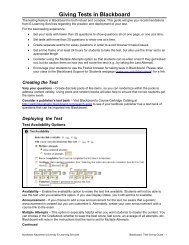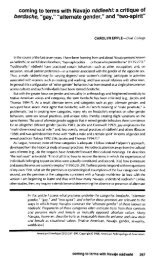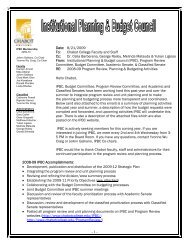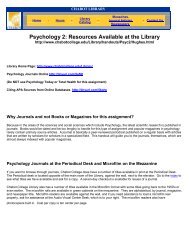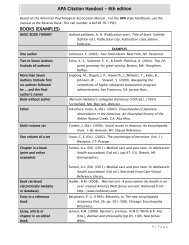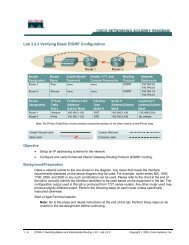BSI Self-Assessment Summary.rtf - Chabot College
BSI Self-Assessment Summary.rtf - Chabot College
BSI Self-Assessment Summary.rtf - Chabot College
Create successful ePaper yourself
Turn your PDF publications into a flip-book with our unique Google optimized e-Paper software.
Effective Practice Area D: Instructional Practices<br />
D.1: Sound principles of learning theory are applied in the design and delivery of courses in<br />
the developmental program.<br />
D.2: Curricula and practices that have proven to be effective in specific disciplines are<br />
employed.<br />
D.3: The developmental education program addresses the holistic development of all aspects<br />
of the student. Attention is paid to the social and emotional development of students, as well<br />
as to their cognitive growth.<br />
D.4: Culturally Responsive Teaching theory and practices are applied to all aspects of the<br />
developmental instructional programs and services.<br />
D.5: A high degree of structure is provided in developmental education courses.<br />
D.6: Developmental education faculty employ a variety of instructional approaches to<br />
accommodate student diversity.<br />
D.7: Programs align entry/exit skills among levels and link course content to college-level<br />
performance requirements.<br />
D.8: Developmental education faculty routinely share instructional strategies.<br />
D.9: Faculty and advisors closely monitor student performance.<br />
D.10: Programs provide comprehensive academic support mechanisms, including the use of<br />
trained tutors.<br />
Despite its central importance, Area D is the shortest section of our self-assessment. This is in part<br />
because many of the above issues have been addressed in earlier sections, such as the integration<br />
and expansion of tutoring services under the Learning Connection, questions about entry/exit<br />
requirements related to assessment and placement, the insufficient time and funding available for<br />
faculty to share instructional strategies, and the limited staff development targeted to developmental<br />
education.<br />
Because most of the above instructional practices are dispersed across a wide range of courses and<br />
instructors (in <strong>Chabot</strong>’s decentralized and minimally coordinated developmental education “program”), it<br />
is difficult to assess how extensively practices like D1-D5 occur. The above list of effective practices<br />
does, however, provide guidance we can use in our upcoming work to design professional development<br />
activities, curricular changes, and academic support services to strengthen developmental education at<br />
<strong>Chabot</strong>.





